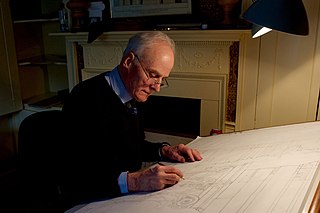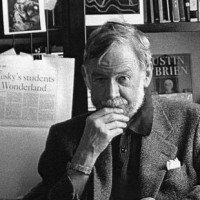
An architect is a person who plans, designs and oversees the construction of buildings. To practice architecture means to provide services in connection with the design of buildings and the space within the site surrounding the buildings that have human occupancy or use as their principal purpose. Etymologically, the term architect derives from the Latin architectus, which derives from the Greek, i.e., chief builder.

Victorian architecture is a series of architectural revival styles in the mid-to-late 19th century. Victorian refers to the reign of Queen Victoria (1837–1901), called the Victorian era, during which period the styles known as Victorian were used in construction. However, many elements of what is typically termed "Victorian" architecture did not become popular until later in Victoria's reign, roughly from 1850 and later. The styles often included interpretations and eclectic revivals of historic styles (see Historicism). The name represents the British and French custom of naming architectural styles for a reigning monarch. Within this naming and classification scheme, it followed Georgian architecture and later Regency architecture, and was succeeded by Edwardian architecture.

East Melbourne is an inner-city suburb in Melbourne, Victoria, Australia, 2 km (1.2 mi) east of Melbourne's Central Business District, located within the City of Melbourne local government area. East Melbourne recorded a population of 4,896 at the 2021 census.
Fender Katsalidis (FK) is an architecture firm which originated in Melbourne, Victoria, Australia, and now has additional studios in Sydney and Brisbane. Founded by Karl Fender and Nonda Katsalidis, the firm has been notable since the early 1990s, producing many landmark buildings in Melbourne and other Australian cities. The firm has previously been known as Nation Fender, then Nation Fender Katsalidis and later Fender Katsalidis.

Glenn Marcus Murcutt AO is an Australian architect and winner of the 1992 Alvar Aalto Medal, the 2002 Pritzker Architecture Prize, the 2009 American Institute of Architects Gold Medal and the 2021 Praemium Imperiale. Glenn Murcutt works as a sole practitioner without staff, builds only within Australia and is known to be very selective with his projects. Being the only Australian winner of the prestigious Pritzker Prize, he is often referred to as Australia's most famous architect.

John Quinlan Terry CBE is a British architect. He was educated at Bryanston School and the Architectural Association School of Architecture. He was a pupil of architect Raymond Erith, with whom he formed the partnership Erith & Terry.
Justine Clark is an architectural editor, writer, speaker and researcher, based in Melbourne, Australia. She is the editor of Parlour, a former editor of Architecture Australia, and co-author of Looking for the Local: Architecture and the New Zealand Modern.
Nonda Katsalidis is a Greek-Australian architect. He is currently a practising director of architecture firm Fender Katsalidis Architects in partnership with Karl Fender.

Woods Bagot is a global architectural and consulting practice founded in Adelaide, South Australia. It specialises in the design and planning of buildings across a wide variety of sectors and disciplines. Former names of the practice include Woods & Bagot, Woods, Bagot & Jory; Woods, Bagot, Jory & Laybourne Smith; Woods, Bagot, Laybourne-Smith & Irwin; and Woods Bagot Architects Pty Ltd.

Peter Russell Corrigan was an Australian architect and was involved in the completion of works in stage and set design.
John Wardle is a Melbourne-based architect. He graduated from the Royal Melbourne Institute of Technology with a degree in Architecture.
Grimshaw Architects is an architectural firm based in London. Founded in 1980 by Nicholas Grimshaw, the firm was one of the pioneers of high-tech architecture. In particular, they are known for their design of transport projects including Amsterdam Bijlmer ArenA railway station, Waterloo International railway station and the award-winning Southern Cross railway station which was the recipient of the Royal Institute of British Architects Lubetkin Prize. Grimshaw is behind the design of the Sustainability Pavilion, an innovative net-zero building, for Expo 2020. The firm currently has offices in Los Angeles, New York, London, Paris, Dubai, Melbourne and Sydney, employing over 600 staff.
Hudson and Wardrop was formed by Philip Burgoyne Hudson and James Hastie Wardrop in 1919. Hudson was born in Auckland, New Zealand on 6 February 1887 and died in 1952 at the age of 64. James Wardrop was born in 1891 and died on 25 July 1975 at the age of 84. Both architects were veterans who served in the war and moved on to study under Charles D'Ebro. The Australian established architects are well known for their designs of chapels, universities, colleges, factories, hotels, and public monuments in Melbourne, the Shrine of Remembrance being the most prominent out of the few. They were also responsible for the compiling of The National War Memorial of Victoria: the first brochure on the first permeated design.
Philip Harmer is an Australian architect. He graduated from the University of Melbourne with a bachelor's degree in Architecture, and became a Fellow of the Royal Australian Institute of Architects (RAIA). Harmer has a strong appreciation for sculptural forms and spaces that are powerfully shaped or wrought; thus, his works display the cleverness of how certain materials and details are used to represent his individual persona.
Walter Richmond Butler, was an Australian architect trained in the Arts and Crafts style, born in Somerset, England.
John Augustus Bernard Koch (1845-1928) was a Melbourne architect who practiced between 1869 and 1913. He also became mayor of Richmond near Melbourne.

New Classical architecture, New Classicism or Contemporary Classical architecture is a contemporary movement in architecture that continues the practice of Classical architecture. It is sometimes considered the modern continuation of Neoclassical architecture, even though other styles might be cited as well, such as Gothic, Baroque, Renaissance or even non-Western styles – often referenced and recreated from a postmodern perspective as opposed to being strict revival styles.
Dimity Reed AM is an architect, urbanist and academic. She has been involved in government advisory roles, as well as writing for both The Sun and The Age newspapers.
The Dimity Reed Melbourne Prize (Architecture) is awarded annually by a jury appointed by the Victorian chapter of the Australian Institute of Architects to projects that have made a significant contribution to the civic life of Melbourne, Australia. It was first awarded in 1997 to Six Degrees Architects for the small bar Meyers Place. The winner is drawn from direct-entry categories in the annual Victorian Architecture Awards, and any project located within the Urban Growth Boundary of the Melbourne metropolitan area is eligible for consideration for the prize which can be drawn from any category in the awards.
Elizabeth K. Meyer is an American landscape architect. She is the Merrill D. Peterson Professor of Landscape Architecture at the University of Virginia.







